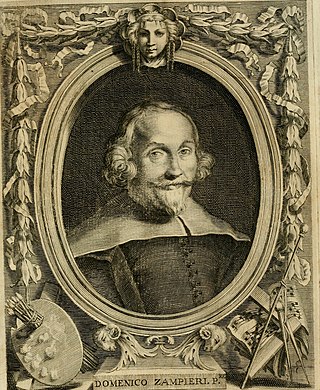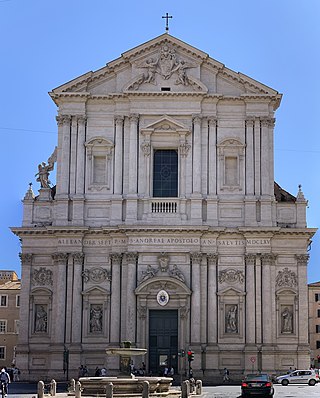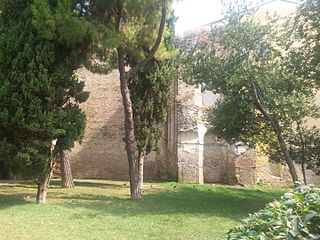
The Church of the Gesù is the mother church of the Society of Jesus (Jesuits), a Catholic religious order. Officially named Chiesa del Santissimo Nome di Gesù, its façade is "the first truly baroque façade", introducing the baroque style into architecture. The church served as a model for innumerable Jesuit churches all over the world, especially in the central Europe and then in the Portuguese colonies. Its paintings in the nave, crossing, and side chapels became models for Jesuit churches throughout Italy and Europe, as well as those of other orders. The Church of the Gesù is located in the Piazza del Gesù in Rome and is one of the great 17th century preaching churches built by Counter-Reformation orders in the Centro Storico.

Domenico Zampieri, known by the diminutive Domenichino after his shortness, was an Italian Baroque painter of the Bolognese School of painters.

Sant'Andrea della Valle is a titular church and minor basilica in the rione of Sant'Eustachio of the city of Rome, Italy. The basilica is the seat of the general curia of the Theatines and is located on the Piazza Vidoni, at the intersection of Corso Vittorio Emanuele and Corso Rinascimento. It is one of the great 17th century preaching churches built by Counter-Reformation orders in the Centro Storico.

The Theatines, officially named the Congregation of Clerics Regular, is a Catholic order of clerics regular of pontifical right for men founded by Archbishop Gian Pietro Carafa on 14 September 1524.

Giovanni Lanfranco was an Italian painter of the Baroque period.

Santa Maria in Vallicella, also called Chiesa Nuova, is a church in Rome, Italy, which today faces onto the main thoroughfare of the Corso Vittorio Emanuele and the corner of Via della Chiesa Nuova. It is the principal church of the Oratorians, a religious congregation of secular priests, founded by St Philip Neri in 1561 at a time in the 16th century when the Counter Reformation saw the emergence of a number of new religious institutes such as the Jesuits, the Theatines, and the Barnabites. These new congregations were responsible for several great preaching churches built in the Centro Storico, the others being Sant'Andrea della Valle (Theatines), San Carlo ai Catinari (Barnabites), and The Gesù and Sant'Ignazio (Jesuits).

Giovanni Giacomo Barbelli was an Italian painter of the Baroque period, active in Lombardy. He was a canvas and fresco painter known for his religious and mythological scenes that decorated many churches and residences in Lombardy. He was a highly skilled draughtsman and a brilliant colorist. His work shows an inventive imagination and a thorough knowledge of perspective.

San Gaetano, also known as Santi Michele e Gaetano, is a Baroque church in Florence, Italy, located on the Piazza Antinori, entrusted to the Institute of Christ the King Sovereign Priest.

The church of Santa Maria delle Grazie in Brescia is located on at the west end of Via Elia Capriolo, where it intersects with the Via delle Grazie. Built in the 16th century and remodeled in the 17th century, it still retains much of its artwork by major regional artists, including one of its three canvases by Moretto. The other two are now held at the Pinacoteca Tosio Martinengo. The interior is richly decorated in Baroque fashion. Adjacent to the church is the Sanctuary of Santa Maria delle Grazie, a neo-gothic work.

San Giovanni in Canale is a Gothic-style Roman Catholic church located on Via Croce #26 in central Piacenza, formerly associated with a Dominican monastery.

San Francesco is a Roman Catholic church, located on Piazza Cavalli #68 in Piacenza, Italy. It was built in a style described as Lombard Gothic and is centrally located facing towards the Piazza del Cavalli, which is surrounded by the Palazzo Gotico and the Palazzo del Governatore.

The Gazzola Institute is a school of the arts and art museum, located on via Gazzola n°9 in the town of Piacenza, region of Emilia Romagna, Italy.

The Church of the Theatines (Teatini), also known as Santa Maria della Pietà is a Roman Catholic, Baroque-style church and monastery located on Corso della Giovecca, in central Ferrara, region of Emilia-Romagna, Italy.

The Church of Santa Sofia is a Roman Catholic church in the city of Lendinara, in the Province of Rovigo, region of Veneto, Italy.

The Chiesa dei Teatini or the church of the Theatines, was a Baroque-style Roman Catholic church located in Rimini, region of Emilia-Romagna, Italy. The church was destroyed during the fierce bombardments preceding the Battle of Rimini in 1944, and only ruins of the interior of the apse remain in a park where the church once stood. A plaque recalls the former church.

The Glory of Sant'Andrea Avellino is a painting by the Italian Baroque painter Giovanni Lanfranco, executed in 1624. It is the main altarpiece of the chapel of Sant'Andrea Avellino in the church of Sant'Andrea della Valle in Rome, Italy.

Santa Cristina is a Baroque-style, Roman Catholic church located on via Repubblica in Parma, region of Emilia-Romagna, Italy.
The Pinacoteca Comunale of Piazza Armerina is the civic art gallery of the town of Piazza Armerina, province of Enna, region of Sicily, Italy.
The Oratory of San Cristoforo is a deconsecrated former Roman Catholic church or chapel located at the chamfered corner of Vie Gregorio X and Angelo Genocchi, in the north-central sector of the historic center of Piacenza, Italy. It rises a block North West of the former Chiesa Sacro Cuore (Gesu) erected by the Jesuits and now housing the Teatro Gioia. The oratory presently houses an exposition space and museum named the Piccolo Museo della Poesia.

The Palazzo dei Priori is a 13th-century civic palace located in Piazza del Plebiscito in central Viterbo, region of Lazio, Italy. Known in the past also as the Palazzo della Commune or Comunale, it now houses both municipal offices and the Museo dei Portici, which houses the famous altarpieces by Sebastiano del Piombo, depicting a Pietà and a Flagellation. The Palace is connected and accessible through an arch over Via Filippo Ascenzi to the former Palazzo del Governatore or Palazzo del Podesta, behind which rises a tall medieval clock tower. Its largest bell deriving from the church of Santa Maria della Verita. Across the piazza on the north end of the Palazzo dei Priori is the church of Sant'Angelo in Spatha, which has a marble replica of the Ancient Roman Sarcophagus of Bella Galiana on the facade. To the left of the palace, facing the piazza is the baroque Palazzo della Prefettura.




















